Zotac's Ion: The World's First mini-ITX Ion Board
by Anand Lal Shimpi on May 12, 2009 12:00 AM EST- Posted in
- GPUs
Putting It in Perspective: The Atom Takes on a Single-Core Pentium 4
When the Atom first appeared I immediately did my best to characterize its performance. Intel always referred to it as having the performance of a 90nm Pentium M but never really got as specific as I would like. In my subsequent testing I found that at 1.6GHz, Intel’s Atom performed like a 1.2GHz 90nm Pentium M (Dothan). If you had a Pentium M notebook back then, the comparison makes sense to you. If you didn’t, however, then you’d need another reference point.
I realized I had no idea how Atom compared to an old Pentium 4. To remedy the situation I dug up an old Dell based on a single-core, Northwood based (130nm) Pentium 4 running at 2.66GHz. These chips used a 533MHz FSB and had a 512KB on-die L2 cache. The system had an ATI Radeon X800 XT and 2GB of DDR memory. This Pentium 4 did not have Hyper-Threading, this was before HT made its official desktop debut.
For my first test I turned to Adobe Photoshop CS4:
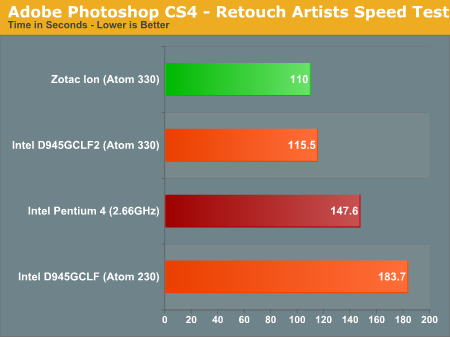
Wow. This is huge. Intel’s dual-core Atom 330 is 25% faster than the 2.66GHz Pentium 4. The advantage is all in the extra core though. If you look at the Atom 230 the Pentium 4 beats it by almost 20%.
Next I wanted to look at video encoding performance, one of the Pentium 4’s strongpoints. If you remember back then, even the Athlon 64 had difficulty competing with the P4’s encoding prowess. We’ll start with Windows Media Encoder:
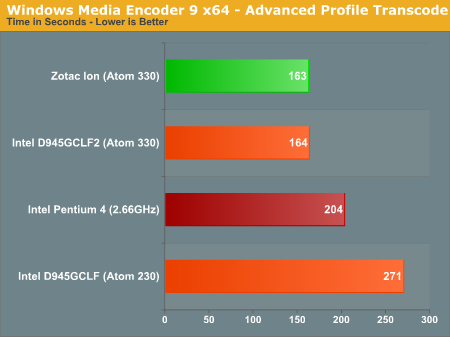
Again, the Atom 330 is faster than the Pentium 4 and again it’s due to the extra core. The Atom 230 is noticeably slower.
x264 encode performance is even more embarrassing for the Pentium 4; the Atom 330 is 62% faster in the first pass and 94% faster in the 2nd pass of the encode. The P4 system was 15% faster than the Atom 230 in the first pass and around 5% faster in the second pass.
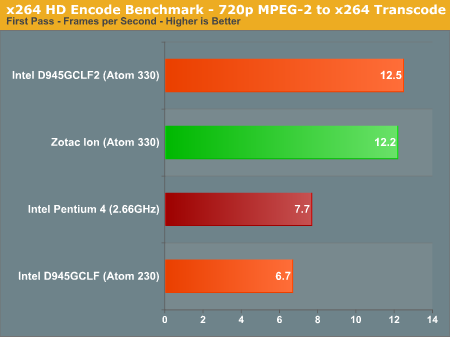
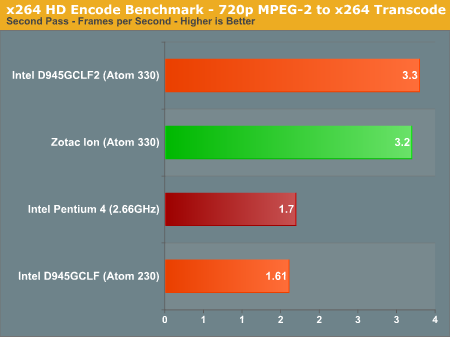
Next up was Cinebench. This is an interesting benchmark to look at because it offers both a single-threaded and multi-threaded benchmark. The Pentium 4 without Hyper-Threading can only execute a single thread, so the multi-threaded test can’t run. I’ve combined the meaningful results in a single chart:
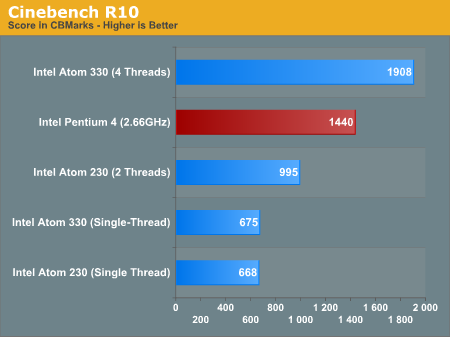
If we look at single-threaded performance, the Pentium 4 destroys the Atom - offering more than twice the performance of the svelte Atom core. Enable the multi-threaded render and the Atom 330 pulls ahead by 33%. This is the strength of the Atom; it’s clearly not faster than the Pentium 4 when working on a single thread, but exploit its ability to work on four threads simultaneously and it can actually be faster than a much larger, much more power hungry Pentium 4. This is a very important point to remember because despite losing to the Atom 330 in nearly all of the benchmarks, the Pentium 4 system it felt much faster than the Atom system in normal usage.
Simple things like opening up Control Panel or switching between windows felt faster on the old Pentium 4 system, which makes sense given that those tasks only spawn a single thread. In Cinebench we saw that the single-threaded performance of the old Pentium 4 was over twice as fast as the Atom - you tend to notice performance differences of that magnitude.
The final application test I ran was our WinRAR compression benchmark:
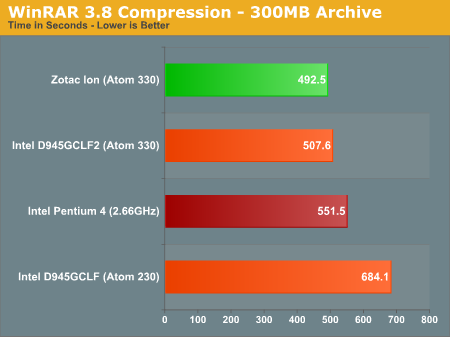
Once more, the Pentium 4 gets beat by the Atom 330 but turns the tables on the Atom 230. Even file compression is multi-threaded these days, and that is the Atom’s saving grace.
I wanted to know how well the GeForce 9300 could stand up against the old Dell’s Radeon X800 XT so I ran my WoW test on both systems. This is less of a CPU test and more of a CPU + GPU test obviously, but the results are interesting:
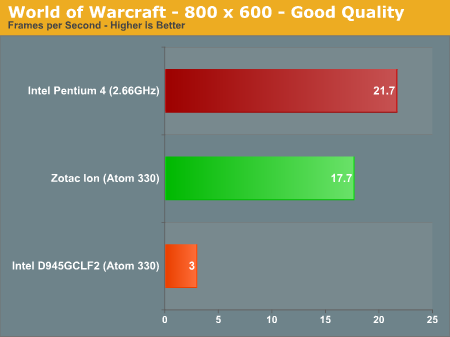
The Pentium 4 + X800 XT system is clearly faster, but not by as much as I expected. The advantage amounts to 22.5%, which is very noticeable, but close enough that if you had an even older system (or one with a lesser video card) you might not notice the performance difference between it and the Zotac Ion.
The last benchmark I ran comparing the Atom to a Pentium 4 was Futuremark’s Peacekeeper - a benchmark for measuring web browser performance. The benchmark is unaffected by internet connection and simply measures, once loaded, how fast your PC can work with various forms of commonly used javascript. I ran all of the Peacekeeper tests using Google Chrome:
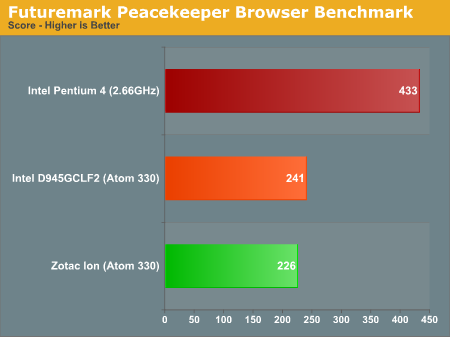
The Pentium 4 absolutely demolished the Atom here. Once again it’s almost twice as fast as the Atom 330. In a multi-threaded environment the Atom 330 can pull ahead, but in most typical day-to-day tasks the Pentium 4 is going to be a much faster solution.
Power efficiency is obviously where the Atom based Zotac Ion wins out. AMD and Intel both viewed the move to multiple cores as a performance and power efficiency win, and the results below help show that. Granted Atom is built on a 45nm process and we’re looking at a 130nm desktop Pentium 4 system, which is where much of the difference really comes from. But the results do show you that if you don’t need top bin performance you can build a very capable PC these days with significantly better power consumption characteristics.

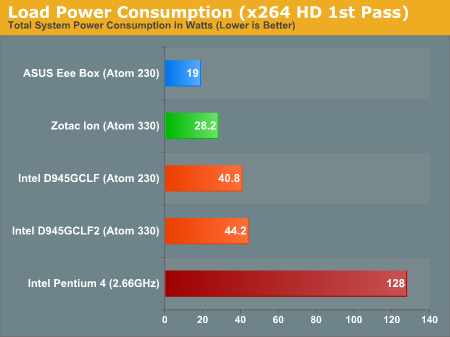
NVIDIA is forever arguing with me about how Atom and its Ion platform is a significant upgrade to PCs that are a few years old. My Pentium 4 results show that unfortunately, that’s not exactly the case. The Pentium 4 system I compared Zotac’s Ion to could never function as a modern-day HTPC and it won’t play Blu-ray discs. In those senses, Zotac’s Ion would be a tremendous upgrade. Even in multi-threaded CPU bound scenarios such as video encoding or 3D rendering, a dual-core Atom 330 is appreciably faster than the old Pentium 4 based Dell system. However, in normal web browsing and simply interacting with Windows, the Pentium 4 is significantly faster. The benchmarks show a nearly 2x performance advantage in single-threaded applications and I’d say they are accurately reflected in the usage experience.










93 Comments
View All Comments
Badkarma - Wednesday, May 13, 2009 - link
Thanks Anand, will definitely drop you a note regarding this over the weekend. It's quite unfortunate that Zotac left out Wake-On-USB for their 9300/9400 mobos, something many consider essential in an HTPC build.djc208 - Tuesday, May 12, 2009 - link
If I didn't have so many projects already I'd seriously consider one of these as the basis of a CarPC system. It's not cheap but a good touchscreen car monitor will run you far more.NNix - Tuesday, May 12, 2009 - link
On page 5: "Once more, the Pentium 4 gets beat by the Atom 330 but loses to the Atom 230"I hope you will review Cortex A8-based Netbooks once they show up. Because Im not impressed at all with Atom, not when looking at <45W dualcore Athlons. Taking into account that those are at 65nm aswell the Atom aint looking that efficient.
nubie - Tuesday, May 12, 2009 - link
I would take a Celeron 420 any day of the week over an Atom or a dualcore athlon ;)GaryJohnson - Tuesday, May 12, 2009 - link
Celery is for eating, not computing.nubie - Wednesday, May 13, 2009 - link
"Celery is for eating, not computing."Sorry, let me be perfectly clear, I would like a Core2 Conroe-L from 1.6-2.0 ghz (every one I have used will easily go over 3 ghz with no voltage increase)
Look at the raw numbers between the Atom and the Conroe-L and tell me on a desktop/stationary machine (IE not a netbook) you wouldn't rather have something more than twice as powerful.
I realize it is called a "celeron", but it is the most freaking powerful (Core2 architecture) Celeron ever sold.
They cost $25-35 on ebay, the LGA 775 version of this board is only $139. It makes a whole lot of sense if you don't plan on running it on battery power.
Not to mention you can move all the way up to a Quad if you want, but a $60 e5200 2.5ghz 2MB Level 2 Cache seems like a perfect match.
Oh, and you get a PCI-e 2.0 X16 slot :P http://www.newegg.com/Product/Product.aspx?Item=N8...">http://www.newegg.com/Product/Product.aspx?Item=N8...
For $10 more it makes a whole lot of sense. (If you already have the LGA 775 chip laying around it makes even more sense.)
npp - Tuesday, May 12, 2009 - link
What could have made this board perfect is a PCI-E slot to stick some decent audio in. Anyone seen mini PCI-E sound cards around :)Visual - Wednesday, May 13, 2009 - link
Why would you want a sound card for any computer made in the last 10 years? Even with the fanciest card, there would not be even one bit of difference on the digital outputs, which are the ones you should be connecting to your receiver. On the analog outputs there will be quality differences indeed, but if you're using them you deserve what you get :p Besides, I get the feeling you wouldn't notice the difference anyway as if you're that stupid to be using them you are also probably using some crappy speakers.flipmode - Tuesday, May 12, 2009 - link
"Everyone seemed to want a Ion based motherboard after I first previewed the platform."Yeah, it is all because of you :roll:
Is that x264 encoding that you used to test power consumption? Why that? The most power draw likely comes from the chipset. Test Blu-Ray playback or something.
Pandamonium - Tuesday, May 12, 2009 - link
The first comment was pretty rude and uncalled for, I must say.I wanted to see an Ion-based HTPC after the preview and this article confirmed that an Ion-based HTPC is what I should set my sights on next. The only improvement Zotac could have made is to include a PCIe slot for TV tuners, audio, or beefed up video. A higher rated Atom would be nice too, but I don't even know that one exists.